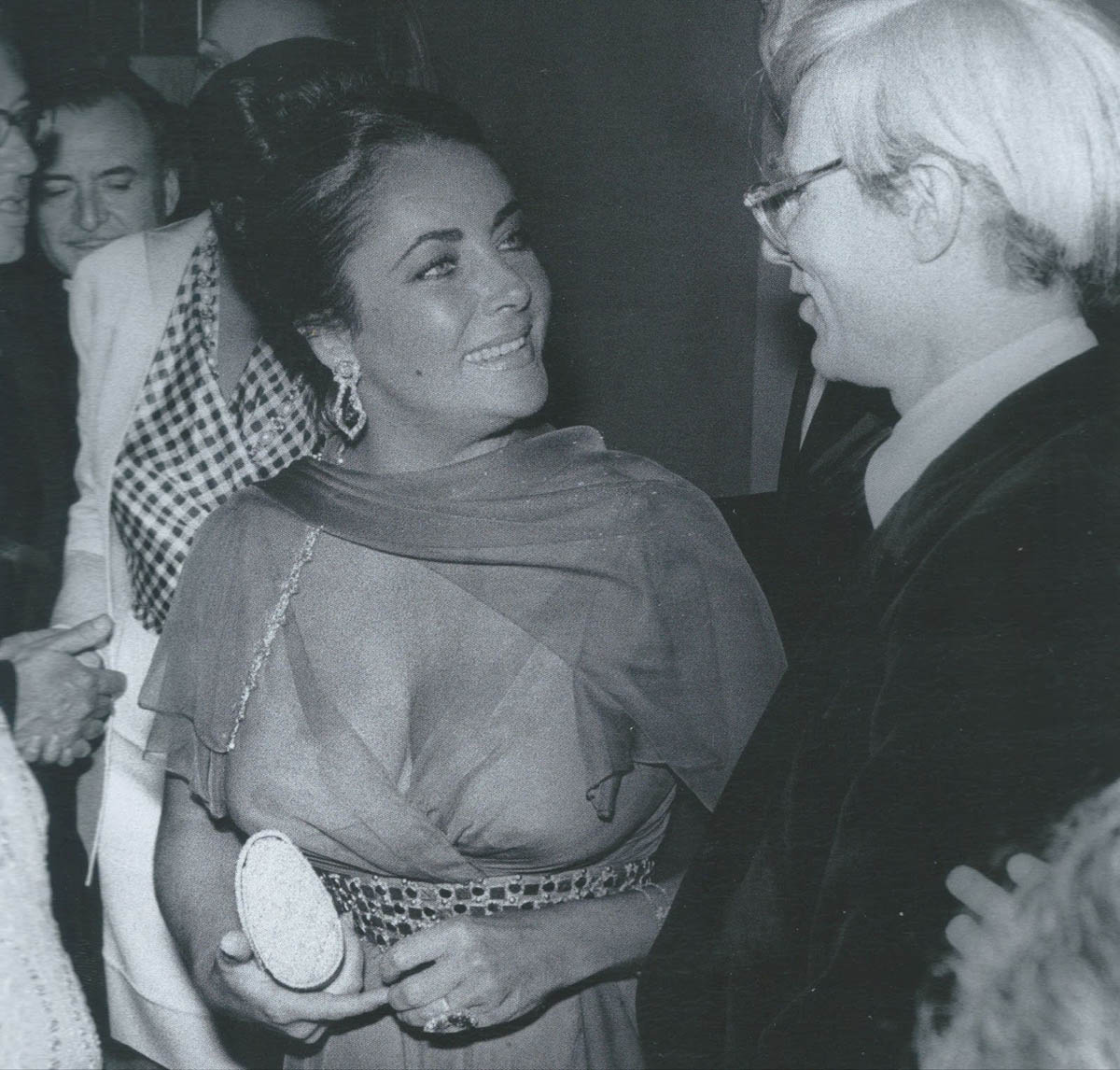
Art & Friendship: How Elizabeth Met Andy Warhol
Elizabeth Taylor and Andy Warhol’s introduction brought together two true 20th century icons. After all, one of the biggest names in film and one of the biggest names in art coming together was bound to impact culture for years to come. Long before their friendship developed in the 70’s, Andy was greatly inspired by Elizabeth’s fame and used her likeness in over fifty works at various points in her life and career, from a bright-eyed child actress in National Velvet to a commanding queen in Cleopatra. He had not yet met Elizabeth at the point that he decided to make her a subject of his art starting in 1962, but with years of being enamored with her image, it made sense for him to include her in his work. To the adage “Write what you know,” Andy added, “Paint whom you worship.”

“Blue Liz As Cleopatra” by Andy Warhol, 1969. © 2025 The Andy Warhol Foundation for the Visual Arts, Inc. / Licensed by Artists Rights Society (ARS), New York.
Their chance meeting would not come until July 7, 1973, a decade after he painted her and a month before his 45th birthday. The two finally came face to face in Rome, on the set of Franco Rossellini’s Driver’s Seat, which starred Elizabeth as a glamorous but self-destructive woman, and featured Andy in a small role as her potential killer. When Elizabeth arrived to set the first day Andy was there, his friend and former editor of Interview Magazine notes in his Gagosian essay, “At forty-one, she was still one of the greatest beauties of her generation. And yes, her eyes really were purple.” After running through her scene, perfectly on her first take, Rossellini introduced Andy to Elizabeth, suggesting the two get to know each other over a drink. Elizabeth regaled Andy with stories of meeting other notable figures like the Kennedys and of her relationship with Richard Burton, and the two showed each other their scars — Elizabeth’s from a crushed vertebrae and Andy’s from where he had been shot in 1968. Bob remembers the meeting fondly, saying, “Andy was in a state of ecstasy. He was hanging out with Elizabeth Taylor, and she was going on and on about his favorite subject, sex, even using four-letter words.”
The following day, Elizabeth and Andy shot their scene together, with Elizabeth “sweetly holding his hand between takes to calm his nerves.” That October, the two shot together again, this time tackling what Andy called his “big love scene with Liz,” though it was less of a love scene and more of an awkward exchange between the characters. As Bob recalls, “Andy had what for him was a very long speech — ten consecutive lines — which he found impossible to memorize. Elizabeth helped him through the endless retakes by regaling him with ‘The History of My Jewelry’ while filling him with Debauched Marys” — her take on a Bloody Mary.
During their first conversation, Elizabeth revealed that she had called The Factory, Andy’s Manhattan studio, the decade prior, with the hope of getting one of her portraits. Surprisingly, she had been refused. Andy asserted there must have been some sort of mistake, and later, he gave her a signed print of his piece “Red Liz.”


“Red Liz,” signed by Andy Warhol, 1963 © 2025 The Andy Warhol Foundation for the Visual Arts, Inc. / Licensed by Artists Rights Society (ARS), New York.; A handwritten thank you note from Elizabeth to Andy, 1977.
Though they did enjoy a friendship that lasted across decades, their personal relationship wasn’t always easy. One night in particular, the two found themselves in a fight after Elizabeth discovered that Andy had been secretly recording their conversation over dinner, which she felt was an invasion of her privacy and betrayal of her trust. The incident understandably marred their friendship, but though they had tumultuous times, Andy always maintained admiration for Elizabeth — he was famously heard to quip how as a choice of afterlife, he would like to be reincarnated as a “big ring” on Taylor’s finger.

“A Big Kiss,” drawn by Andy Warhol for Elizabeth. This piece hung in a powder room off the living room in Elizabeth’s home, and was later sold in her Christie’s auction. © 2025 The Andy Warhol Foundation for the Visual Arts, Inc. / Licensed by Artists Rights Society (ARS), New York.
Their relationship, and the breadth of her presence across his work, was commemorated in 2011 by the prestigious Gagosian Gallery in New York, with both an exhibition of Andy’s portraits of Elizabeth and the publication of an accompanying art book. Of the work, the Gagosian said, “The personification of charisma whose highly public life was charged with drama, tragedy, and romance, this iconic muse was a perfect vehicle for Warhol’s vivid silkscreen portraiture derived from press clippings, publicity shots, and film stills.”
Elizabeth’s impact can be traced across countless areas of culture. By not only serving as the inspiration for some of the most iconic works of the century but forging personal relationships with influential artists, she made an indelible mark on the art world.

Installation view at the Warhol: Liz exhibition at the Gagosian Gallery, 2011
Installation view at the Warhol: Liz exhibition at the Gagosian Gallery, 2011. © 2025 The Andy Warhol Foundation for the Visual Arts, Inc. / Licensed by Artists Rights Society (ARS), New York.